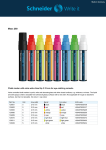Download Traxxas TQ-3 User's Manual
Transcript
The Traxxas TQ-3 Radio System Your T-Maxx 3.3 is equipped with the TQ-3 radio system. The TQ-3 is a 3-channel system that provides up to a quarter mile range and control for up to three servo outputs. The TQ-3 works in conjunction with the OptiDrive™ Electronic Shift Module to monitor and control the input and output signals for the throttle and shifting servos (channels). The OptiDrive monitors the voltage of the on-board batteries. The "Function" LED will flash red if the battery voltage is too low. TQ-3 Transmitter Antenna T-Maxx 3.3 Wiring Diagram The OptiDrive ESM is designed to adapt and work with aftermarket three channel radio systems (see page 15). 4-cell Battery Holder Throttle Neutral Adjust Steering Wheel Throttle Trim On/Off Switch Antenna Steering Trim Receiver Steering Servo Reverse Shift OptiDrive ESM (Electronic Shift Module) Forward Shift Battery Channel 1 Channel 2 Channel 3 Throttle Trigger Shifting Servo CH.1 CH.2 CH.3 Throttle/Brake Servo Servo Reversing Switch Power Switch Battery Compartment Power Indicator To Transmission (OptiDrive sensor) T-MAXX 3.3 • 9 The Traxxas TQ-3 Radio System Radio System Terminology Learn terms related to the TRX 3.3 Racing Engine beginning on page 20. Please take a moment to familiarize yourself with these radio-system terms. They will be used throughout this manual. Neutral position - The standing position that the servos seek when the transmitter controls are at the neutral setting. 5-Cell Pack – Another term for RX Pack or rechargeable receiver pack. The RX pack is made up of five rechargeable NiMH battery cells and is used in place of the 4AA batteries in the model. NiCad - Abbreviation for nickel-cadmium. The original rechargeable hobby pack, NiCad batteries have very high current handling, high capacity, and can last up to 1000 charging cycles. Good charging procedures are required to reduce the possibility of developing a “memory” effect and shortened run times. Channel - The 27 MHz frequency band is divided into 6 channels so that up to six models can be operated simultaneously. Each channel is referred to by its flag color and channel number, as shown below. 1 Frequency Band 26.995 Flag Color Brown Traxxas Part No. 2031 2 27.045 Red 2032 3 27.095 Orange 2033 4 27.145 Yellow 2034 5 27.195 Green 2035 6 27.255 Blue 2036 Channel Clearing your frequency - A routine, verbal check to make sure nobody else in your area is operating on the same channel. Always clear your frequency by calling out your channel number before operating your model. Wait or move to another area if your channel is already being used. Crystal (X-tal) - The plug-in device that determines which channel the radio system will operate on. For each channel, there are two crystals, one for the receiver and one for the transmitter. Of those two crystals, the one marked “RX” with the lower number (.455 MHz lower) must be inserted into the receiver. Frequency band - The radio frequency used by the transmitter to send signals to your T-Maxx 3.3. All Traxxas RTR models operate on a 27 MHz frequency band. mAh – Abbreviation for milliamp hour. Measure of the capacity of the battery pack. The higher the number, the longer the battery will last between recharges. 10 • T-MAXX 3.3 NiMH - Abbreviation for nickel-metal hydride. Rechargeable NiMH batteries offer high current handling, and much greater resistance to the “memory” effect. NiMH batteries generally allow higher capacity than NiCad batteries. They can last up to 500 charge cycles. A peak charger designed for NiMH batteries is required for optimal performance. Receiver - The radio unit inside your T-Maxx 3.3 that receives signals from the transmitter and relays them to the servos. RX Pack - RX is a common abbreviation for the radio receiver and items associated with it. RX Pack denotes the optional rechargeable battery pack used to power the radio system in the model. It is available as Traxxas part number 3037. Servos - Small motor units in your T-Maxx 3.3 that operate the throttle and steering mechanisms. Three-channel radio system - The TQ-3 radio system, consisting of the receiver, the transmitter, and the servos. The system uses three channels: one to operate the throttle, one to shift the transmission, and one to operate the steering. Transmitter - The hand-held radio unit that sends throttle and steering instructions to your T-Maxx 3.3. Trim - The fine-tuning adjustment of the neutral position of the servos, made by turning the throttle and steering trim knobs on the face of the transmitter. The Traxxas TQ-3 Radio System Installing Transmitter Batteries Your TQ-3 transmitter uses 8 AA batteries. The battery compartment is located in the base of the transmitter. Use the Right Batteries CH.1 CH.2 CH.3 4. Turn on the transmitter and check the power indicator for a solid red light. If the power indicator light flashes, then the transmitter batteries are weak, discharged or possibly installed incorrectly. Replace with new or freshly charged batteries. The power indicator light does not indicate the charge level of the batteries installed in the model. 1. Remove the battery compartment door by pressing the tab and lifting the door up. 2. Install the batteries in the correct orientation as indicated in the battery compartment. 3. Reinstall the battery door and snap it closed. Your transmitter uses AA batteries. Use new alkaline batteries, or rechargeable batteries such as NiCad or NiMH (Nickel Metal Hydride) batteries in your transmitter. Make sure rechargeable batteries are fully charged according to the manufacturer’s instructions. If you use rechargeable batteries in your transmitter, be aware that when they begin to lose their charge, they lose power much more quickly than regular alkaline batteries. Caution: Discontinue running your T-Maxx 3.3 at the first sign of weak batteries (flashing red light) to avoid losing control. If the power indicator doesn’t light red, check the polarity of the batteries. Check rechargeable batteries for a full charge. T-MAXX 3.3 • 11 The Traxxas TQ Radio System Installing Receiver Batteries Direct the battery wires through the slot in the battery cover. If the wires are not properly routed, they may become broken or shorted, causing radio system failure and loss of control. If you use rechargeable batteries in your receiver, be aware that when they begin to lose their charge, they lose power much more quickly than regular alkaline batteries. Signs of weak receiver batteries include sluggish steering response and shortened radio range. Caution: Discontinue running your T-Maxx 3.3 at the first sign of weak batteries to avoid losing control. If the radio system doesn’t appear to work when the transmitter and receiver switches are turned on, check for correct battery installation. 12 • T-MAXX 3.3 The radio receiver in your T-Maxx 3.3 uses 4 AA batteries. The battery holder for the receiver batteries is located underneath the battery cover. The battery cover can be identified by the on/off switch. 1. Remove the battery cover by removing the two 3x10mm buttonhead cap screws On/Off Switch from the cover. 2. Remove the battery holder and install 4 AA alkaline batteries. Make careful note of the battery polarity by comparing against the diagrams in the battery holder. 4-cell battery holder 3. Insert the battery holder into the battery cover. 4. Reinstall the battery cover and secure with the screws (see sidebar!). To prevent losing control of your model, it is important to stop at the first sign of weak receiver batteries. Visible warning signals include sluggish steering response and shortened radio range. In addition, the Optidrive is equipped with a lowvoltage indicator and a failsafe circuit. When the voltage of the receiver batteries drops below 4.3 volts, the “Function” LED on the OptiDrive will flash red. If the voltage drops below 4.3 volts for more than 2 seconds, the OptiDrive ignores throttle and shift signals and applies 25% brakes (failsafe mode). Steering will still be operational and the “Function” LED on the OptiDrive will flash red. The OptiDrive will stay in failsafe mode until the power is turned off or the receiver battery voltage rises above 4.3 volts for more than 2 seconds. Anytime the “Function” LED flashes red, it is time to stop and install new batteries (or recharge your battery pack if equipped). Do not try to continue running your model with weak receiver batteries on board. Traxxas TRX Power System (optional) The optional Traxxas TRX Power System can be purchased separately to power the radio system in the T-Maxx 3.3. Benefits include the economy of a rechargeable 5-cell nickel metal hydride (NiMH) battery pack that replaces AA alkaline batteries, and increased voltage for dramatically improved servo performance. The TRX Power Charger (Part #3030X) is a peakdetecting unit that will charge the RX Power Pack (Part #3036 flat pack or #3037 hump pack) in about one hour. The peak detection circuitry automatically shuts off the charger when the maximum charge has been achieved. The TRX Power Charger also includes a 7.2V adapter for charging 7.2V EZ-Start batteries. The TRX Power Charger can operate on either AC or DC power. A special wiring harness for T-Maxx (Traxxas part #3034) that includes a handy external charging jack is required. The optional DC car adapter (Part #3032) features a tangle-free, extra long wire and integrated fuse. The long charging cord allows the model to remain outside the car while charging. Caution! Never charge batteries in an enclosed car interior or while driving. Never leave charging batteries unattended. Monitor them closely. Traxxas' integrated TRX Power System is the easiest way to add the power and economy of rechargeable batteries to your T-Maxx 3.3. Consult your hobby dealer for purchasing information. The Traxxas TQ-3 Radio System Setting up the Antenna 1. Locate the black antenna wire that exits the top of the receiver box. Antenna Tip Antenna Sleeve 2. Pull the wire straight with your fingers and then insert the end of the wire into one end of the antenna tube (the antenna tube, tip, crimp nut and sleeve are located in the documents bag). Push the wire all the way through the antenna tube. 3. Insert the base of the tube into the antenna post. Take care not to crimp the antenna wire. Antenna Tube 4. Slide the crimp nut over the antenna tube and screw it onto the antenna post. Use the supplied tool to tighten the crimp nut on the post just until the antenna tube is securely in place. Do not over tighten or crush the antenna wire against the receiver box. 5. Fold the top of the antenna wire over the top of the antenna tube. Slide the antenna sleeve over the tube to retain the antenna wire. Now slide the antenna tip onto the top of the antenna tube. Never cut or shorten the antenna wire. Antenna Wrench 6. On the transmitter, always fully extend the telescoping antenna when running your T-Maxx 3.3. Make a habit of holding the transmitter so the antenna points straight up. Spray a little window cleaner on the antenna wire to make it easier to push through the antenna tube. Don’t shorten the length of the antenna wire. Its length is tuned to the frequency band; cutting it could severely shorten the radio system’s range. Don’t push the transmitter antenna down from the top. Pull it down from the bottom, one segment at a time, to prevent binding and kinking the antenna mast. Antenna Crimp Nut Antenna Post T-MAXX 3.3 • 13 The Traxxas TQ-3 Radio System TQ-3 Radio System Controls TQ-3 Radio System Adjustments In addition to the electronic throttle and steering trim controls, your radio system features throttle neutral adjustment and servo reversing switches. Throttle Neutral Adjustment RN RIGHT TU Shift Reverse N LEFT TUR Steering The throttle neutral adjustment is located on the transmitter face and controls the forward/reverse travel of the throttle trigger. Change the adjustment by pressing the button and sliding it to the desired position. There are two settings available: 50/50: Allows equal travel for both acceleration and braking. 70/30: Allows more throttle travel (70%) and less brake travel (30%). 50/50 is the required setting for T-Maxx 3.3 with the TRX 3.3 Racing Engine. Brake Neutral Electronic Throttle Trim CH.1 CH.2 CH.3 Accelerate Shift Forward The electronic throttle trim located on the face of the transmitter adjusts the neutral (center) point of the throttle servo when the servo is at rest. This control has been preset for you at the factory. If necessary, adjust the control so that the carburetor is at idle, and the brakes are not applied (the model will roll freely). Do not use the throttle trim to raise or lower the engine idle speed. Make the idle speed adjustment on the carburetor. Electronic Steering Trim The electronic steering trim located on the face of the transmitter adjusts the neutral (center) point of the steering servos when the servos are at rest. Adjust this control to make the model drive straight with no steering input at the wheel. 14 • T-MAXX 3.3 The Traxxas TQ-3 Radio System Servo Reversing Switches The servo reversing switches are located on the front of the transmitter, next to the on/off switch. Moving a switch reverses the direction of the corresponding servo. Each switch corresponds to a channel, as shown below. For example, if you turn the steering wheel to the right and your front wheels turn left, you would move the channel 1 switch to correct the servo direction. It may be necessary to adjust the corresponding trim control after moving a switch. The default position for the servo reversing switches is shown. CH.1 2. Set the TQ-3 Transmitter to its factory default shift settings: Set the THROTTLE NEUTRAL switch to the 50/50 setting. Set the THROTTLE TRIM to the center “0” setting, then adjust the throttle linkage until the carburetor closes. Set the CHANNEL 2 SERVO REVERSING SWITCH to the right position. Set the CHANNEL 3 SERVO REVERSING SWITCH to the right position. DO NOT change the position of any of the servo reversing switches after programming the OptiDrive. If settings were changed after programming the OptiDrive, it will have to be reprogrammed. CH.2 CH.3 TQ-3 Channel to Servo Chart Channel 1 2 3 Servo Steering Throttle and braking Shifting ™ Programming the OptiDrive ESM The OptiDrive ESM electronically monitors vehicle speed and controls forward and reverse shifting. Controlling the shift action electronically rather than by mechanical systems reduces the number of components in the transmission. The transmission weighs less, there is lower rotational mass for quicker acceleration, and constant drive engagement for smooth power delivery. The OptiDrive module prevents the transmission from changing directions while the truck is in motion. The truck must be completely stopped to change directions, regardless of the position of the shift selector switch on the transmitter. The OptiDrive module is preset at the factory. If the transmitter throttle trim adjustment is changed, then the OptiDrive module will need to be re-programmed. 1. The engine must be shut off. The radio system must be on (receiver and transmitter). 3. With the throttle at neutral, press and hold the SET button until the Function LED flashes green twice and then release the button immediately. You are now in programming mode. 4. Pull the transmitter throttle trigger to the full throttle position. Hold it there until the Function LED flashes green three times. Note: The throttle servo will not move during programming even though it is connected to the controller. 5. Release the transmitter throttle trigger allowing it to return to neutral. The Function LED will turn solid green, indicating that the shifting servo is OK to shift and the programming has been completed. The controller is now programmed and ready to go! If the transmitter throttle settings are changed, it will be necessary to complete the programming sequence again. If the SET button is released before the Function LED flashes green twice in step 3, the OptiDrive will return to the normal operation mode. If you experience any problems during programming, turn the receiver off, then on again, and repeat the programming steps. For instructions on how to use the OptiDrive with aftermarket radio systems, or to access advanced programming options, visit our website, www.Traxxas.com. Large adjustments to the throttle trim and/or throttle linkage may require re-setting the OptiDrive to maintain proper shifting action. For transmission durability, the OptiDrive ESM limits the model’s reverse speed to about 70% of full throttle. If settings are changed, and you notice a decrease in forward top speed, you could have the OptiDrive system reversed. Return the TQ-3 servo-reversing switches for channels two and three back to their default settings and re-program the OptiDrive Module. For programming with aftermarket radio systems, please see our website. OptiDrive Operation • Green “Function” Shift allowed • Red flashing “Function” Low battery, see pg. 12 • Red “Sensor” a) Sensor, throttle or shift circuit is broken. Possible disconnected or broken sensor, throttle or shift wires. Possible damaged sensor. b) Receiver has lost signal from the transmitter, the OptiDrive has entered fail-safe (throttle and shift servos become unresponsive). • Blue flashing “Sensor“ Normal operation as vehicle moves. Indicates signal pulse from sensor. Depending on the rotor position, solid blue or off when vehicle is at rest. T-MAXX 3.3 • 15 The Traxxas TQ-3 Radio System Always have the transmitter and receiver turned on before you start the engine. Never turn the radio system off while the engine is running. The on/off switch in the model only turns the receiver on and off. It does not turn off the engine. TQ-3 Radio System Rules Remember, always turn the TQ-3 transmitter on first and off last to avoid damage to your T-Maxx 3.3. Never turn the radio off while the engine is running. Each time you prepare to run your T-Maxx 3.3, you must clear your frequency to be sure no one else in the area is using the same channel as you. Channel 1 Brown Channel 2 Red Always use new or freshly charged batteries for the transmitter, and make sure the receiver batteries are fresh. The function light on the OptiDrive will flash red if the receiver batteries become weak. Weak batteries will limit the radio signal between the receiver and the transmitter. Loss of the radio signal can cause you to lose control of your T-Maxx 3.3. Channel 3 Orange There are six possible channels, numbered 1 through 6. Each is represented by a color. Look at the crystal plugged into the back of your transmitter to determine which channel your truck is assigned to. Channel 4 Yellow Channel 5 Green Channel 6 Blue Always turn your TQ-3 transmitter on first and off last. This procedure will help to prevent your T-Maxx 3.3 from receiving stray signals from another transmitter, or other source, and running out of control. CH.1 CH.2 CH.3 16 • T-MAXX 3.3 1 2 3 Always turn your transmitter on first. Always turn your receiver on second. Then start your engine. The Traxxas TQ-3 Radio System Using the TQ-3 Radio System The TQ-3 Radio System was pre-adjusted at the factory. The adjustment should be checked before running the model, in case of movement during shipping. Here’s how: 1. Fully extend the chrome antenna mast on the transmitter and turn the switch on. The red indicator light on the transmitter should be solid red (not flashing). 2. Turn on the receiver switch in the model. The switch is located in the top of the radio compartment. The function light on the OptiDrive ESM should be green. A red flashing LED indicates low voltage in the receiver batteries. The sensor LED is intermittent depending on the rotor position. 3. Position T-Maxx 3.3 so that its front wheels are off the ground. 4. Turn the steering wheel on the transmitter back and forth and check for rapid operation of the steering servo. Also, check that the steering mechanism is not loose or binding. If the steering operates slowly, then make sure you have fresh receiver batteries . 5. When looking down at model, the front wheels should be pointing straight ahead. If the wheels are turned slightly to the left or right, slowly adjust the steering trim control on the transmitter until they are pointing straight ahead. 7. Operate the shift button on the transmitter and check for rapid operation of the shifting servo. Push the shift button down for forward. The servo will operate the spring-loaded shift mechanism and you will hear the transmission click into forward. Push the shift button up for reverse and you will again hear the transmission click and shift into gear. 8. Once adjustments are made, turn off the receiver on your T-Maxx 3.3, followed by the hand-held transmitter. Range-Testing the TQ-3 Radio System When the engine is running, don’t use the throttle trim on the transmitter to adjust the engine idle speed. Instead, use the idle speed adjustment on the carburetor. Do not use the throttle trim as an “idle up” function for starting or you could affect the OptiDrive programming Before each running session with your T-Maxx 3.3, you should range-test your radio system to ensure that it operates properly. 1. Turn on the radio system and check its operation as described in the previous section (Using the TQ-3 Radio System). 2. Have a friend hold the model with the engine off. 3. Make sure your transmitter antenna is fully extended, and then walk away from the model with the transmitter until you reach the farthest distance you plan to operate the model. Don’t attempt to operate your T-Maxx 3.3 if there are any problems with your radio system or radio interference at your location. 4. Operate the controls on the transmitter once again to be sure that the model responds correctly. Throttle 6. Operate the throttle trigger on the transmitter and check for rapid operation of the throttle servo. When the throttle trigger is pulled back, the carburetor should open (slide moves out). When the throttle trigger is pushed all the way forward, the brake should lock. 5. Do not attempt to operate the model if there is any problem with the radio system or any external interference with your radio signal at your location. Brake Throttle/Brake Servo Shifting Servo Steering Servo T-Maxx 3.3 Servo Operation T-MAXX 3.3 • 17






















